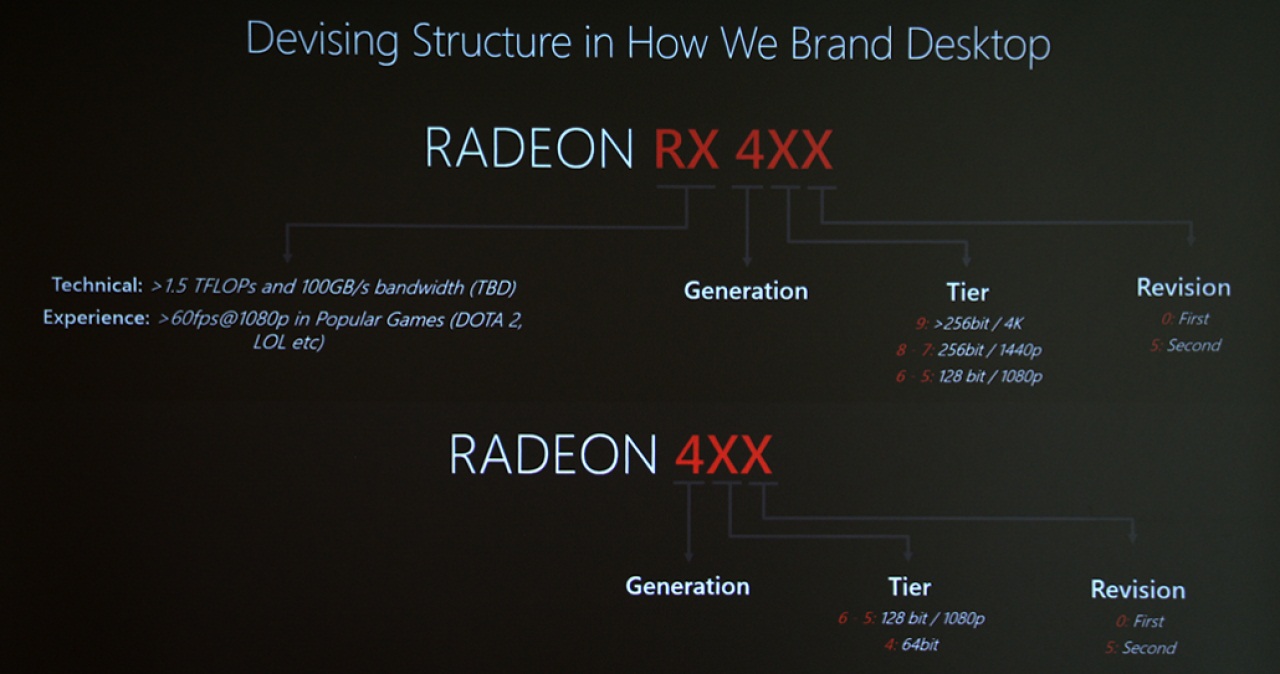^ The entire analysis above would have made a lot more sense except for the fact that Polaris 10 is an R9 380/X market segment replacement. For the 100th time, we have 4 designating a new generation, and the 2nd number is the class of card it is replacing:
R9 380/X -> RX 480
R9 380 was a $199 videocard and R9 380X was a $229 videocard. These were not $299-349 videocards:
http://www.anandtech.com/show/9387/amd-radeon-300-series/2
http://www.anandtech.com/show/9784/the-amd-radeon-r9-380x-review
The other major flaw in the argument is that AMD already had a mid-range $329 R9 390 8GB a long time ago before Polaris 10 launched. How would AMD aim to expand TAM if they released a $299-$349 RX 480 and $249-279 RX 470 when they already were selling $250 R9 290 and $330 R9 390? The logic makes no sense. The only way to try and expand TAM was to bring R9 290/970 VR-spec to lower price levels. It's why AMD emphasized how the $349 VR-minimum was too high of a price for the average/mainstream consumer.
Secondly, next generation similar tier cards tend to replace the previous level tier at similar TDP levels. What does that mean? It means in much the same way how 140-150W 970 and 170-180W 980 were replaced by 140-150W 1070 and 180-190W 1080, AMD would need to replace the R9 390/X with a card having ~ 200-225W TDP, leaving 250-300W for the Fury/X replacement [of course we don't know yet if AMD will abandon the 250-300W tier this generation because this segment for AMD barely sells].
Does it look like Polaris 10 was meant to be an R9 390/970/980 replacement meant to compete with GTX1070/1080?! Absolutely not.
Thirdly, previous rumours indicated that AMD's flagship succeeding Fury X would be 15-18B transistors. How can you have such a massive chip and such a small Polaris 10 and nothing in the middle? That's because there is a mid-range tier AMD has not released yet.
This is the same flawed argument HardOCP used when Polaris 10 launched, completely misunderstanding AMD's naming convention, market strategy, product planning and SKU positioning.
It doesn't get more obvious:
RX 470 replaced R9 270X
RX 480 replaced R9 380/380X
You might as well call this the mainstream GPU segment. AMD is yet to release the performance and high-end segments.
We don't know if AMD will have 2 more tiers because companies change their strategies. At the very least we can somewhat reasonably estimate that AMD should have at least 2 more distinct tiers above Polaris 10 -- the $329-449 segment (hint: R9 390/X replacement tier), and $549-699 segment (hint: Fury/X replacement tier).
The idea that AMD planned to have RX 480 at $300-350 before 1070 launched simply makes no sense.
All of this comes down to the fact that people to this date cannot fathom, believe and accept that AMD and NV are bifurcating GPU generations now. 7970/680 = mid-range and the high-end tier got pushed back by both firms as 780/780Ti/R9 290/X. Next generation we got the exact same thing where 970/980 were mid-range and because AMD had no $ to design a new product, they refreshed 290/X as 390/X. Then we got the high-end which was 980Ti/Fury X.
This is the 3rd generation in a row that the cycle is repeated:
RX 470/480/1060 = these are low-end / mainstream videocards. For crying out loud, the 1060 is GP106, the exact (!) lineage successor to the $149 GF106 GTS450:
http://www.anandtech.com/show/3909/nvidias-geforce-gts-450-pushing-fermi-in-to-the-mainstream
The next GPU tier is mid-range / upper-mid-range. That's GTX1070/1080 and AMD's response to date is nothing yet.
The next GPU tier is high-end/flagship. That's 1080Ti/Titan XP and AMD's response to date is nothing yet.
Finally, for nearly 2 decades of GPU generations, next gen replacement tiers are faster than the previous generation tier they replaced. RX 470/480 are not faster than R9 390/X tier, which automatically means they can't be their replacements. It's why RX 480 is 60-64% faster than R9 380, similar to how 1070/1080 are ~ 65% faster than 970/980.
It seems the whole premise that RX 480 was meant to be a $300-350 card meant to compete with GP104 simply comes down to PC gamers refusing to accept that GP104 is mid-range/upper-mid-range $199-249 GTX560/Ti tier. It's a way for them to feel better about paying $400-700 for 1070/1080 since they think: "Well, Polaris 10 was meant to be the competitor but AMD failed miserably. No competition means I have no choice but to pay these prices." That's why the next explanation they have is: "AMD failed so hard with RX 480 against 1070, they had to reduce the price from $349 to $239."
Too much hanging out on HardOCP forums, huh?
R9 270/X -> RX 470
R9 380/X-> RX 480 4/8GB
R9 390/X -> RX 490 (?)
Fury/Fury X -> Who knows what this will be called.
Since AMD is lagging behind NV in perf/mm2, and perf/watt, they need 14nm to mature for higher yields to clock Vega higher to be competitive. They need prices of larger 14nm die to drop to be able to make $$ with a larger Vega chip than GP104. They also need HBM2 to mature, hit volume production and prices to drop to be able to have $329-499 HBM2 cards that actually make $. If you want to argue that AMD should have designed a Vega hard with GDDR5X instead of HBM2, that's a fair criticism to make against AMD.
Considering for every single GPU generation, except for GeForce 4 where ATI skipped a generation entirely & HD2900/3870, NV never beat the equivalent ATI/AMD by more than 20%, and taking into account that AMD actually had faster cards last 2/3 times (7970Ghz > 680, R9 290X > 780Ti, 980Ti > Fury X), it's laughable to suggest that RX 480 was meant to cost $300-350 and meant compete with GP104, and ended up 50-80% slower:
https://www.techpowerup.com/reviews/MSI/GTX_1070_Gaming_Z/26.html






